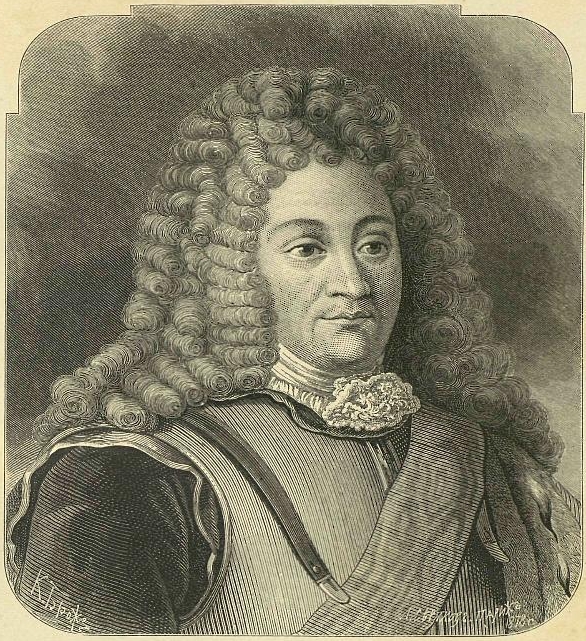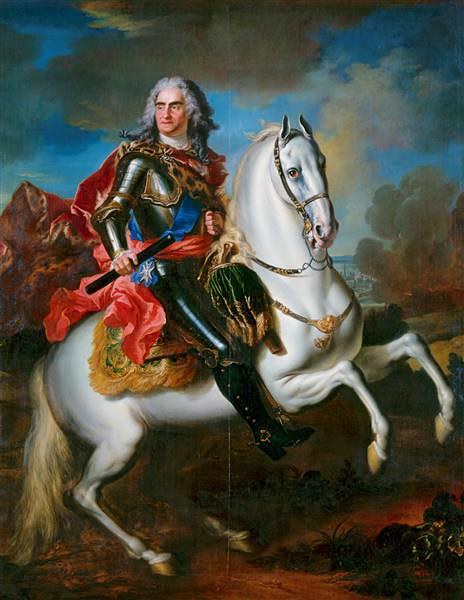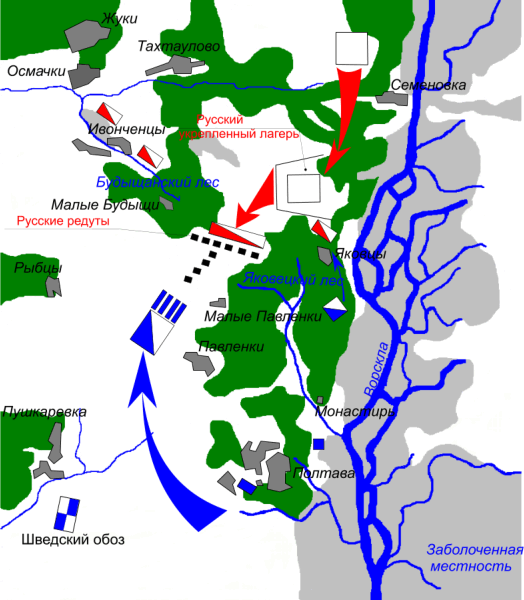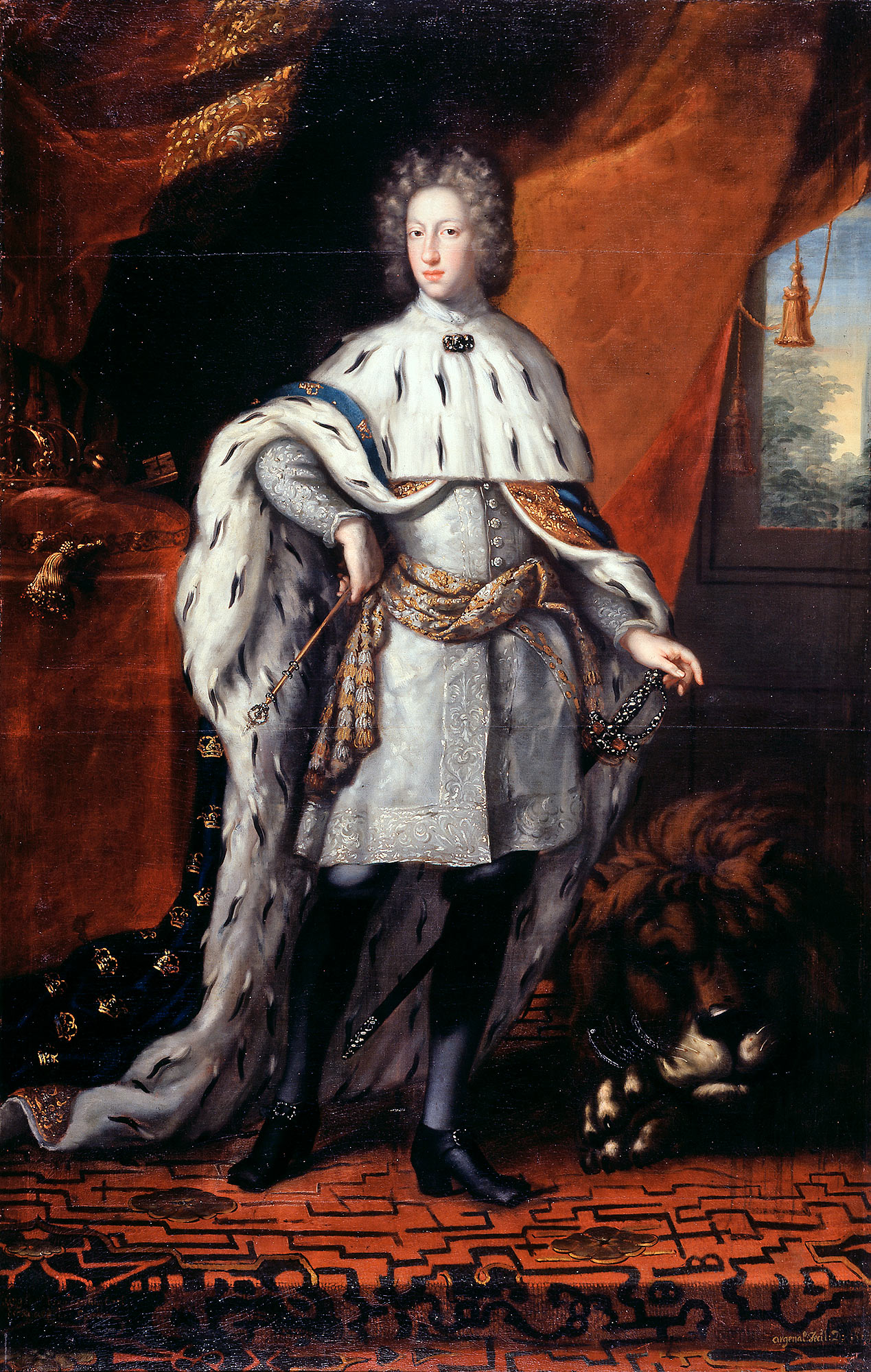|
Siege Of Stralsund (1711–1715)
The siege of Stralsund was a battle during the Great Northern War. The Swedish Empire defended her Swedish Pomeranian port of Stralsund against a coalition of Denmark-Norway, the Electorate of Saxony and the Tsardom of Russia, which was joined by the Kingdom of Prussia during the siege. A first attempt to take Stralsund was made in 1711, when the allies closed in on the town. Swedish relief forced the coalition to withdraw from the fortifications, whereupon the besieging armies drew a wider ring along the lines of the Recknitz and Peene rivers. Magnus Stenbock's victory at Gadebusch for a short time distracted the allies, but after Stenbock's pursuit and subsequent defeat, Prussia as well as Hanover, ruled in personal union with Great Britain, joined the anti-Swedish alliance. The allies agreed that Denmark should cede her claims to Bremen-Verden to Hanover, and in turn Denmark was promised the northern parts of Swedish Pomerania with Stralsund, while the southern parts were ... [...More Info...] [...Related Items...] OR: [Wikipedia] [Google] [Baidu] |
Great Northern War
In the Great Northern War (1700–1721) a coalition led by the Tsardom of Russia successfully contested the supremacy of the Swedish Empire in Northern Europe, Northern, Central Europe, Central and Eastern Europe. The initial leaders of the anti-Swedish alliance were Peter the Great, Peter I of Russia, Frederick IV of Denmark, Frederick IV of Denmark–Norway and Augustus II the Strong of Electorate of Saxony, Saxony–Polish–Lithuanian Commonwealth, Poland–Lithuania. Frederick IV and Augustus II were defeated by Sweden, under Charles XII, and forced out of the alliance in 1700 and 1706 respectively, but rejoined it in 1709 after the defeat of Charles XII at the Battle of Poltava. George I of Great Britain and the Electorate of Hanover joined the coalition in 1714 for Hanover and in 1717 for Britain, and Frederick William I of Prussia, Frederick William I of Brandenburg-Prussia joined it in 1715. Charles XII led the Swedish army. Swedish allies included Holstein-Gottorp, sev ... [...More Info...] [...Related Items...] OR: [Wikipedia] [Google] [Baidu] |
Kingdom Of Prussia
The Kingdom of Prussia (, ) was a German state that existed from 1701 to 1918.Marriott, J. A. R., and Charles Grant Robertson. ''The Evolution of Prussia, the Making of an Empire''. Rev. ed. Oxford: Clarendon Press, 1946. It played a significant role in the unification of Germany in 1871 and was a major constituent of the German Empire until its German Revolution of 1918–1919, dissolution in 1918. Although it took its name from the Prussia (region), region called Prussia, it was based in the Margraviate of Brandenburg. Its capital was Berlin. The list of monarchs of Prussia, kings of Prussia were from the House of Hohenzollern. The polity of Brandenburg-Prussia, predecessor of the kingdom, became a military power under Frederick William, Elector of Brandenburg, known as "The Great Elector". As a kingdom, Prussia continued its rise to power, especially during the reign of Frederick the Great, Frederick II "the Great".Horn, D. B. "The Youth of Frederick the Great 1712–30." ... [...More Info...] [...Related Items...] OR: [Wikipedia] [Google] [Baidu] |
Finland
Finland, officially the Republic of Finland, is a Nordic country in Northern Europe. It borders Sweden to the northwest, Norway to the north, and Russia to the east, with the Gulf of Bothnia to the west and the Gulf of Finland to the south, opposite Estonia. Finland has a population of 5.6 million. Its capital and largest city is Helsinki. The majority of the population are Finns, ethnic Finns. The official languages are Finnish language, Finnish and Swedish language, Swedish; 84.1 percent of the population speak the first as their mother tongue and 5.1 percent the latter. Finland's climate varies from humid continental climate, humid continental in the south to boreal climate, boreal in the north. The land cover is predominantly boreal forest biome, with List of lakes of Finland, more than 180,000 recorded lakes. Finland was first settled around 9000 BC after the Last Glacial Period, last Ice Age. During the Stone Age, various cultures emerged, distinguished by differen ... [...More Info...] [...Related Items...] OR: [Wikipedia] [Google] [Baidu] |
Bender, Moldova
Bender (, ) or Bendery (, ; ), also known as Tighina ( mo-Cyrl, Тигина, links=no), is a city within the internationally recognized borders of Moldova under ''de facto'' control of the unrecognized Transnistria, Pridnestrovian Moldavian Republic (Transnistria) (PMR) since 1992. It is located on the western bank of the river Dniester in the historical region of Bessarabia. Together with its suburb Proteagailovca, the city forms a municipality, which is separate from Administrative-Territorial Units of the Left Bank of the Dniester, Transnistria (as an administrative unit of Moldova) according to Moldovan law. Bender is located in the buffer zone established at the end of the 1992 War of Transnistria. While the Joint Control Commission has overriding powers in the city, Transnistria has ''de facto'' administrative control. The Tighina Fortress, fortress of Tighina was one of the important historic fortresses of the Principality of Moldova until 1812. Name First mentioned in ... [...More Info...] [...Related Items...] OR: [Wikipedia] [Google] [Baidu] |
Treaty Of Copenhagen (1709)
On 22 October 1709, during the Great Northern War, the alliance between the Russian Empire and Denmark-Norway was renewed in the Treaty of Copenhagen. Charles XII of Sweden had destroyed the previous alliance in Travendal (1700). For Russia, Vasily Lukich Dolgorukov signed the treaty in Copenhagen. See also * Treaty of Copenhagen (other), for other treaties known by this name Sources * External linksScan of the treaty at IEG Mainz {{Great Northern War treaties Copenhagen Copenhagen ( ) is the capital and most populous city of Denmark, with a population of 1.4 million in the Urban area of Copenhagen, urban area. The city is situated on the islands of Zealand and Amager, separated from Malmö, Sweden, by the ... 1709 treaties 1709 in Denmark 1700s in Poland Treaties of the Russian Empire Treaties of Denmark–Norway Bilateral treaties of Russia ... [...More Info...] [...Related Items...] OR: [Wikipedia] [Google] [Baidu] |
Treaty Of Thorn (1709)
Concluded on 9 October 1709, the Treaty of Thorn was an agreement signed in Thorn (Toruń) between Augustus the Strong of the Polish-Lithuanian Commonwealth and his counterpart, Peter the Great the Tsar of Russia. Through this agreement, the two parties revived an alliance from an earlier treaty between them in 1699, which their common rival Charles XII of Sweden had dismantled through the 1706 Treaty of Altranstädt. In the 1709 treaty, the two parties agreed to restore the Polish crown to Augustus among various other provisions with different implications for both parties and their respective nations. A close examination of the background to the agreement as well as the terms, implementation, and implications of the Treaty of Thorn underscores its significance in marking the Tsar’s and Russia’s ascendance into a powerful regional player in northeastern Europe. Background During the Great Northern War, a resounding Russian victory had brought down Charles XII and his Pol ... [...More Info...] [...Related Items...] OR: [Wikipedia] [Google] [Baidu] |
Polish–Lithuanian Commonwealth
The Polish–Lithuanian Commonwealth, also referred to as Poland–Lithuania or the First Polish Republic (), was a federation, federative real union between the Crown of the Kingdom of Poland, Kingdom of Poland and the Grand Duchy of Lithuania, existing from 1569 to 1795. This state was among the largest, most populated countries of 16th- to 18th-century Europe. At its peak in the early 17th century, the Commonwealth spanned approximately and supported a multi-ethnic population of around 12 million as of 1618. The official languages of the Commonwealth were Polish language, Polish and Latin Language, Latin, with Catholic Church, Catholicism as the state religion. The Union of Lublin established the Commonwealth as a single entity on 1 July 1569. The two nations had previously been in a personal union since the Union of Krewo, Krewo Agreement of 1385 (Polish–Lithuanian union) and the subsequent marriage of Queen Jadwiga of Poland to Grand Duke Jogaila of Lithuania, who was cr ... [...More Info...] [...Related Items...] OR: [Wikipedia] [Google] [Baidu] |
Battle Of Poltava
The Battle of Poltava took place 8 July 1709, was the decisive and largest battle of the Great Northern War. The Russian army under the command of Tsar Peter I defeated the Swedish army commanded by Carl Gustaf Rehnskiöld. The battle would lead to the Swedish Empire losing its status as a European great power and also marked the beginning of Russian supremacy in eastern Europe. During the course of six years in the initial stages of the war, King Charles XII and the Swedish Empire had defeated almost all participants in the anti-Swedish coalition, which initially consisted of the Polish-Lithuanian Commonwealth, Denmark-Norway and the Tsardom of Russia. The latter, under , was the only one still fighting. Charles therefore chose to invade Russia in the autumn of 1707 and march towards Moscow with a large Swedish army. However, the campaign was complicated by harsh weather conditions and by Russian scorched earth tactics and surprise attacks, which forced Charles to interr ... [...More Info...] [...Related Items...] OR: [Wikipedia] [Google] [Baidu] |
Treaty Of Frederiksborg
The Treaty of Frederiksborg () was a treaty signed at Frederiksborg Castle, Zealand, on 3 July 1720Heitz (1995), p.244 (14 July 1720 according to the Gregorian calendar), ending the Great Northern War between Denmark–Norway and Sweden. History The Danish-Swedish conflict began with Danish attack in 1700 but Sweden forced a peace the same year, while continuing to fight Russia. Denmark rejoined the war in 1709 in a campaign to regain their lost provinces; Scania, Blekinge, and Halland. Denmark participated until the Swedish defeat, primarily at the hands of Russia, in 1721. Sweden paid 600,000 Riksdaler in damages, broke her alliance with Holstein and forfeited her right to duty-free passage of Öresund. Denmark also gained full control over Schleswig, while Danish-held areas of Swedish Pomerania Swedish Pomerania (; ) was a dominions of Sweden, dominion under the Sweden, Swedish Crown from 1630 to 1815 on what is now the Baltic Sea, Baltic coast of Germany and Poland. Foll ... [...More Info...] [...Related Items...] OR: [Wikipedia] [Google] [Baidu] |
Charles XII Of Sweden
Charles XII, sometimes Carl XII () or Carolus Rex (17 June 1682 – 30 November 1718 Old Style and New Style dates, O.S.), was King of Sweden from 1697 to 1718. He belonged to the House of Palatinate-Zweibrücken, a branch line of the House of Wittelsbach. Charles was the only surviving son of Charles XI of Sweden, Charles XI and Ulrika Eleonora the Elder. He assumed power, after a seven-month caretaker government, at the age of fifteen. In 1700, a triple alliance of Denmark–Norway, Electorate of Saxony, Saxony–Polish–Lithuanian Commonwealth, Poland–Lithuania and Tsardom of Russia, Russia launched a threefold attack on the Swedish protectorate of Holstein-Gottorp and provinces of Swedish Livonia, Livonia and Swedish Ingria, Ingria, aiming to take advantage of the Swedish Empire being unaligned and ruled by a young and inexperienced king, thus initiating the Great Northern War. Leading the Swedish army against the alliance, Charles won multiple victories despite being si ... [...More Info...] [...Related Items...] OR: [Wikipedia] [Google] [Baidu] |
Bremen-Verden
Bremen-Verden, formally the Duchies of Bremen and Verden (; ), were two territories and immediate fiefs of the Holy Roman Empire, which emerged and gained imperial immediacy in 1180. By their original constitution they were prince-bishoprics of the Archdiocese of Bremen and Bishopric of Verden. In 1648, both prince-bishoprics were secularised, meaning that they were transformed into hereditary monarchies by constitution, and from then on both the Duchy of Bremen and the Duchy of Verden were always ruled in personal union, initially by the royal houses of Sweden, the House of Vasa and the House of Palatinate-Zweibrücken, and later by the House of Hanover. With the dissolution of the Holy Roman Empire in 1806, Bremen-Verden's status as fiefs of imperial immediacy became void; as they had been in personal union with the neighbouring Kingdom of Hanover, they were incorporated into that state. Territory and insignia The territory belonging to the Duchies of Bremen and Verden cov ... [...More Info...] [...Related Items...] OR: [Wikipedia] [Google] [Baidu] |
Great Britain
Great Britain is an island in the North Atlantic Ocean off the north-west coast of continental Europe, consisting of the countries England, Scotland, and Wales. With an area of , it is the largest of the British Isles, the List of European islands by area, largest European island, and the List of islands by area, ninth-largest island in the world. It is dominated by a maritime climate with narrow temperature differences between seasons. The island of Ireland, with an area 40 per cent that of Great Britain, is to the west – these islands, along with over List of islands of the British Isles, 1,000 smaller surrounding islands and named substantial rocks, comprise the British Isles archipelago. Connected to mainland Europe until 9,000 years ago by a land bridge now known as Doggerland, Great Britain has been inhabited by modern humans for around 30,000 years. In 2011, it had a population of about , making it the world's List of islands by population, third-most-populous islan ... [...More Info...] [...Related Items...] OR: [Wikipedia] [Google] [Baidu] |





